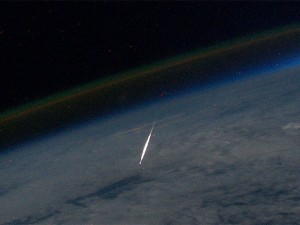Perseids meteor shower this weekend

A Perseid meteor seen from the International Space Station during the 2011 shower. Photo: NASA’s Marshall Space FLight Center, Creative Commons, some rights reserved
Weather permitting, this is a prime weekend for star gazing. The Perseids meteor shower is back and should provided the best viewing Sunday and Monday nights.
According to this from USA Today:
You will have to stay up late to see the Perseids at their peak; the best viewing comes from midnight to dawn, particularly after the half-full moon sets at 1 a.m. on Monday, says Astronomy magazine’s Michael Bakich. But they should appear at night during the week before and after the peak as well.
Star Date has more on meteor showers in general as well as dates for other such events this year.
For historical background, Sky and Telescope has a good article on the “discovery” (human, scientific documentation that is) of the Perseid meteors as an annual event. This happened in the 1830’s – a busy and productive time for the study of meteor showers.
Martha Foley and Aileen O’Donoghue (St. Lawrence physics professor and NCPR’s “go-to” expert for astronomy) chatted about the Perseids in July of 2010, which you can hear again here.
Here’s EarthSky waxing poetic on the event:
August 10-13, 2013 before dawn, the Perseids
The Perseid meteor shower is perhaps the most beloved meteor shower of the year for the Northern Hemisphere. The shower builds gradually to a peak, often produces 50 to 100 meteors per hour in a dark sky at the peak, and, for us in the Northern Hemisphere, this shower comes when the weather is warm. The Perseids tend to strengthen in number as late night deepens into midnight, and typically produce the most meteors in the wee hours before dawn. They radiate from a point in the constellation Perseus the Hero, but, as with all meteor shower radiant points, you don’t need to know Perseus to watch the shower; instead, the meteors appear in all parts of the sky. They are typically fast and bright meteors. They frequently leave persistent trains. Every year, you can look for the Perseids around August 10-13. They combine with the Delta Aquarid shower (above) to produce the year’s most dazzling display of shooting stars. In 2013, the Perseid meteors will streak across the short summer nights – August 10-13 – from late night until dawn, with little to no interference from the waxing crescent moon. Plus the moon will be near the planet Saturn in the evening hours, giving a colorful prelude to late-night Perseid show. Best mornings to look: August 11, 12 and 13.
EarthSky further details the what/where/why of the Perseid meteor shower here.
Tags: astronomy, Perseids meteor showers, science








We’ll be in Algonquin Park on Monday night; looking forward to the Perseids in a pitch black part of Ontario.
We’re camped out in the back yard this week…guarding the plums from marauding raccoons, so we’ll get a pretty good view.
And? Who is seeing what?
I stepped outside at 4 am for the last several nights in a row and saw only the usual star scape. (Very pretty, but nothing streaking across the sky.)
Shall try longer/harder tonight.